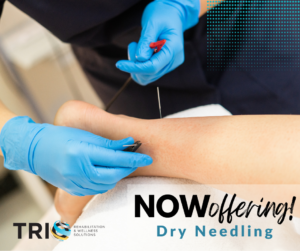22 Nov Dry Needling Therapy – What is it & Who Needs It?
Dry Needling is a pain management treatment performed by a trained physical therapist using a “dry needle,” which is a thin monofilament needle designed to penetrate the skin and treat underlying muscular trigger points. Dry needling, also known as trigger point dry needling and intramuscular stimulation is a proven medical treatment that has been accepted by the American Physical Therapy Association (APTA) and used in modern medicine for many years.
 At Trio Rehab, our skilled physical therapists generally provide trigger point dry needling therapy, which is the specific process of locating and disrupting a tightened muscle tissue area, or taught band, with a dry needle to inactivate the trigger points, reduce pain, and restore function.
At Trio Rehab, our skilled physical therapists generally provide trigger point dry needling therapy, which is the specific process of locating and disrupting a tightened muscle tissue area, or taught band, with a dry needle to inactivate the trigger points, reduce pain, and restore function.
What are other benefits of Dry Needling:
- Relaxes the muscles,
- Boosts blood flow,
- Diminishes inflammation,
- Triggers the healing response, and
- Improves nerve communication, which activates the release of the body’s natural pain relievers.
“Our dry needling therapy approach is inclusive and a part of an overall treatment plan,” Stephanie Compean, Physical Therapist at Trio Rehab, explained. “Once we have determined that Dry Needling is an effective solution for pain management, we will discuss how manual therapy, supportive exercises, and education will also play a role throughout the treatment program,” Stephanie added.
What type of pain does dry needling treat?
Dry Needling is used to increase range of motion that may be limited due to muscle tightness or scar tissue, as well as the following medical conditions:
- Joint problems,
- Disk problems,
- Tendinitis,
- Migraine and tension-type headaches,
- Repetitive motion disorders (like carpal tunnel syndrome),
- Spinal pain,
- Pelvic pain, and
- Much more.
Who should consider Dry Needling?
While dry needling is a growing and effective treatment for managing pain, it is not for everyone. For starters, although it is accepted by the (APTA) and practiced by more and more physical therapists, it is not federally regulated. The practice of Dry Needing is governed by state laws. To learn more about unique Dry Needling practices by state, download the Dry Needling map, courtesy of APTA.
Additionally dry needling therapy may not be appropriate for those diagnosed with a bleeding disorder or taking blood thinners, prone to infections, or have an extreme needle phobia.
We can help!
Now that you know a bit more about Dry Needling therapy and its benefits, don’t suffer with pain. Give us a call, we can help!

Stephanie Compean, Physical Therapist
Trio Rehabilitation & Wellness Solutions
Boerne, Texas


